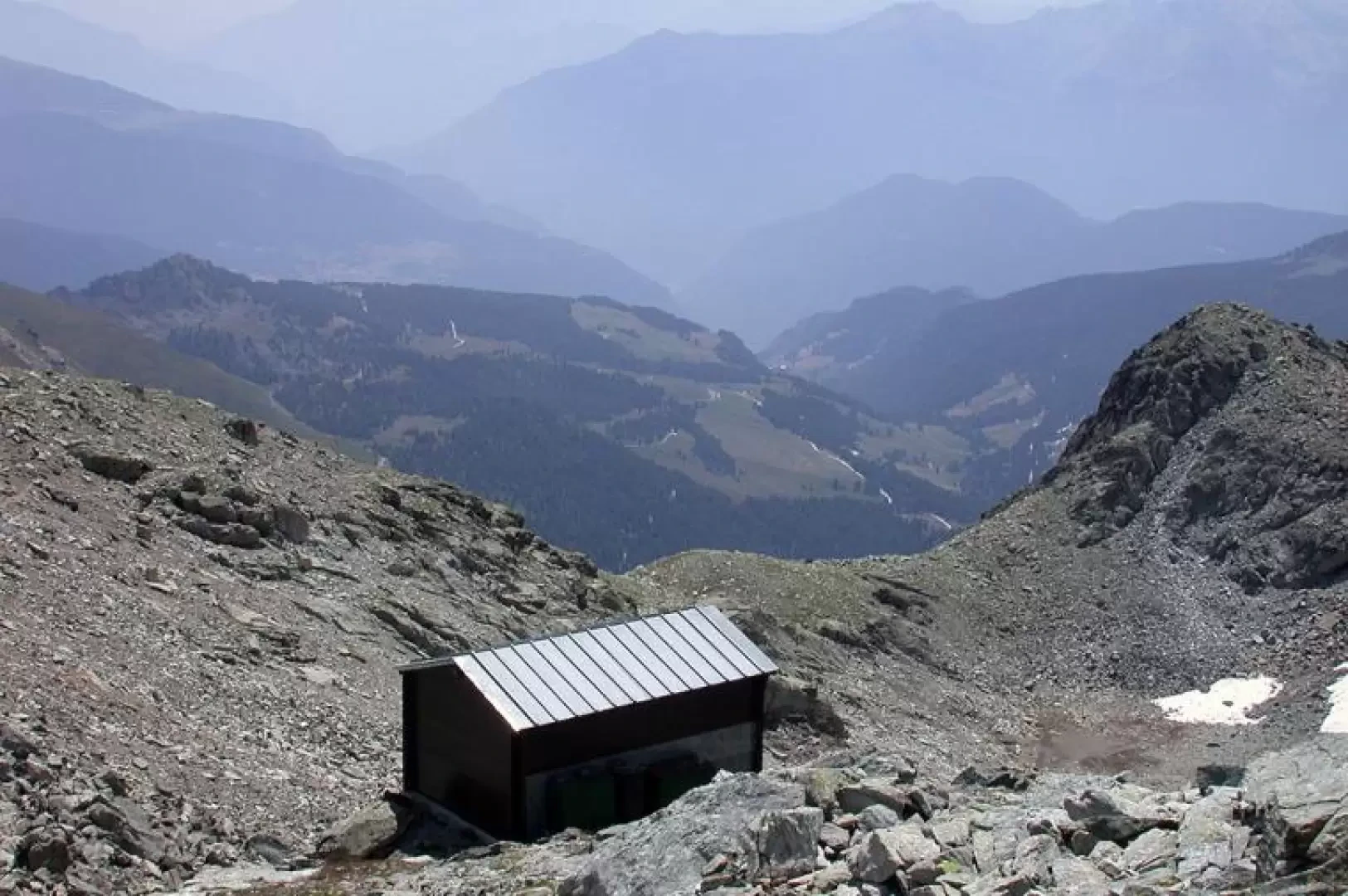Rivolta Bivouac, from Etirol

Access
From the motorway exit at Châtillon/Saint-Vincent turn left and follow the main road up to a roundabout, take the second exit and head west on Via E. Chanoux through the centre of Châtillon, cross the Marmore stream and turn right first into Via Menabrea and then Via Martiri di Chesod before turning onto the regional road , the second exit at the characteristic roundabout with the Matterhorn in the middle. Follow the regional road for 8km to Antey-Saint-André where, at Hotel Filey, turn left to take the regional road to Torgnon. Climb up the regional road for about 6 kilometres to reach the main town of Mognod. Continue straight on, following the signs for the ski lifts. After 400 metres at a hairpin bend to the left, take the municipal road on the right, following the signs for Petit Monde, Triatel and Etirol. Now continue on the narrow road until you reach the village of Triatel and finally that of Etirol, where you will find a small car park 🅿️ near the village. If the car park is full, you can turn around and park near the Moulin.
[0h31'] - [19.6km]
How to get there with GMaps
How to get there with Apple Maps
The information provided here has been verified on the date of the route survey. Before setting off, it is advisable to ensure that no substantial changes have occurred on the route to the starting point. Therefore, we recommend the use of the satellite navigation apps provided by Google or Apple to obtain up-to-date and detailed directions.
Introduction
A splendid hike in a wild corner of the Valtournenche. The ascent to the Rivolta Bivouac and the nearby Col de Fort will allow you to enjoy excellent and unusual views.
Description
At the bridge that crosses the Torgnon stream, which is an emissary of Lake Loditor, the path
for the Tzan bivouac branches off. Care must be taken in the first few metres because water has invaded the path's seat, turning it into a small swamp, but as soon as the slope increases the problem is solved. You enter a sparse larch wood and shortly afterwards follow the main path uphill to the right; be careful not to be misled by the track that leads into the forest on the left.
Coming out of the trees, you cross a stream and after a short climb through the pastures you cross a lonely plateau. You pass an old alpine pasture and again enter the shade of the larches. At the end of the ascent, walk along a small valley, seeing a large mountain pasture in the distance on the other side of the valley, and leaving the ruins of an old lime kiln on the left, now almost covered by vegetation, continue straight on until reaching the Tour des Grandes Montagnes signpost, which you follow in the direction of Loditor. Shortly afterwards, looking down, you can see the imposing ruins of the Chevacour hospice, which served in the Middle Ages to accommodate travellers on their way to Prarayer in Valpelline and then to Switzerland via the Col Collon.
We pass above the Château alpine pasture and head along the dirt road that climbs up offering a beautiful view of the Punta Tsan. At the crossroads with the track that follows the Verrayes canal, turn right and follow it past the start of the path leading to the Tzan bivouac. Continue on level ground at the edge of a beautiful plateau dotted with junipers and rhododendrons. You cross two bridges crossing clear streams fed by meltwater, and at the first one you can see the catchment works of the Verrayes canal (ru de Chavacour) that carries water across the Col des Bornes to the Fontane mountain pasture in the municipality of the same name. At the next crossroads, take the track that climbs to the left and follows the bank of the stream for a stretch, then reach the lay-by where the road ends and take the path that zigzags its way through the shrubs.
A little further on, at the crossroads near a stream, continue uphill until reaching the Grande Drayère mountain pasture, where it intersects with the Alta Via /1berg trail that leads from the Tzan bivouac to the Ersa window. Continue up the ridge following the signs for Col de Fort, and after about ten minutes of steep bends you come out onto a plateau from which you can see the half-barrel construction of the Tzan bivouac in the distance on the right. As the path enters the scree, it gradually becomes less and less defined, while the yellow-painted stretches are joined by cairns. Pass by a boulder marked
and climb up the valley at a gentle slope, leaving the boulders of an old landslide to the right.
The trail heads to the northern side of the valley and becomes steeper, and as you gain height you can see, behind you, two small lakes previously hidden by boulders. You cross a small waterfall, and climb up the slope between rocks and scree until you reach a signpost that has remained unmarked. Follow the ridge in the direction of a cairn and shortly afterwards you come in sight of the bivouac, which you reach after crossing a small snowfield that lasts until late summer.
The Rivolta bivouac, equipped with 10 beds with mattresses and blankets, table, gas and pots and pans, is the preferred starting point for the ascent to Punta Tzan and the east face of Dôme de Tzan. From the Col de Fort you have a beautiful view of the Roisetta lake, the pass allows you to enter the Cignana valley from an unusual direction, you can either head towards the Barmasse hut on a marked path or, knowing the area well, towards the Perucca hut on unmarked tracks.
The descent is along the same route as the outward journey.